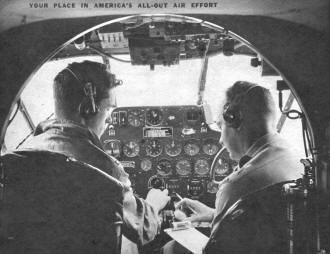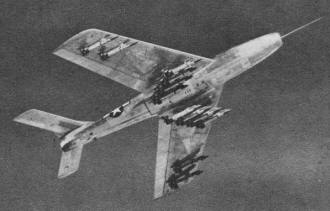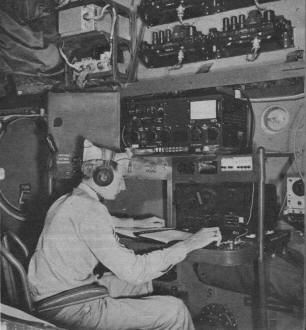|
On May 8, 1945, with the capitulation
of Germany, Italy, and local Axis forces, World War II ended in the European
Theater. Then, on September 2, 1945, with the surrendering of Japan,
World War II ended in the Pacific Theater and in its entirety.
A mere five years later, on June 25, 1950, The U.S. entered into the
Korean War (Conflict). China and Russia, both of which were
allied with us during World War II - and both of which we saved from Japanese
and German, respectively, conquering - backed North Korea in its attempt to take
South Korea by force. There's appreciation for you. During that half-decade
interval, military aircraft had undergone an extreme evolution from propellers
and piston engines to turbines and jet engines. The U.S. Air Force underwent a
major reduction in force shortly after the end of WWII, including cutting the
pilot and navigator staff. Once it became clear that we would be at war again, a
scramble was on to retain the remaining pilots and begin recruiting and training
new pilots. The majority of aircraft in the inventories of the Air Force, Navy,
and Marines were still piston powered, but the need to generate new programs for
both flight and ground maintenance of jet aircraft added a significant burden to
each service's missions. Men with a pre-existing interest and experience in both
full size and model aircraft were sought via publications such as Air Trails.
Our Expanding Air Force

It took intensive screening and training to turn the two men
in the cockpit of this twin-engine aircraft into competent pilot officers.
It's "an organization more highly skilled than ever before ... In flight or on
ground all are specialists
By Major General Richard E. Nugent, USAF
Deputy Chief of Staff, Personnel
Against the threat of Red aggression, the U. S. Air Force is doubling its strength.
The goal for June 30, 1951, is nearly a million officers and Airmen in service compared
to a total of barely half that before the Korean War.
In number of units, the Air Force is building from 48 Groups before Korea to
68 or more by June 30 and at least 84 as rapidly thereafter as possible. Secretary
Finletter has indicated that 95 groups will be built. In World War II, we reached
a peak of 243 groups.
The new units will be harder hitting than those in the last war. Bombers will
be heavier and faster; they will fly farther with more load. The fighters will pack
more fire power in rockets, bombs and guns. Jets which were just being developed
during World War II, will be many.
All this calls for an Air Force more highly skilled than ever before. In today's
Air Groups, in flight or on the ground, everyone is a specialist.
While part of the present manning is by call from Air Force Reserves and Air
National Guard, many of these units are not at full strength and need recruits.
Especially, there is a shortage in such urgently needed occupational skills as electronics,
communications, and aircraft maintenance.
Air Power
The role of air power has been continually expanding through the years. There
is no stopping point in sight. New inventions are announced in rapid succession.
Yet more technical improvements keep coming as the Air Force and air industries
work to keep always ahead.
Aerial warfare is the way to bring wars to a close with the least expenditure
of lives. Allied air supremacy over Europe made it possible to win World War II
with relatively fewer losses than in World War I, when the airplane was little more
than a scouting and light bombing device.
In the Pacific, Japan's early push to gain islands proved to be of no avail.
When we took the offensive, we bypassed the island strongholds and rendered them
helpless by cutting supply lines.

Typical of the new planes coming is the triple-threat ground-support
fighter-bomber Republic F-84F.
When air supremacy was gained over the Japanese homeland, the will to resist
was fast crumbling. When two A-bombs were dropped, a great well-trained and experienced
army surrendered without firing a shot.
It cannot be said too often that the armies of the Communist nations cannot be
matched in numbers. They can be surpassed by technical equipment and skill, in which
America leads the world.
Air Commands
The U. S. Air Force was given separate status by the Unification Act of 1947,
which created a single Department of Defense over three co-equal departments of
Air Force, Army, and Navy. Under its own Secretary and Chief of Staff, who is a
member of the Joint Chiefs the Air Force not only administers its own flying units
but related services such as supply, medical, and communications.
Most Needed Skills
Following are occupational fields in which the Air Force most needs personnel
in its current expansion:
For Airmen: Radio and Radar Maintenance; Communications; Aircraft
and Engine Maintenance; Armament; Weather; Supply; Food Service; Languages.
For Officers: Electronics; Communications; Armament; Finance
and Auditing; Specialized Observer (Radar, Navigator, Bombardier); Engineering (civil'
mechanical, chemical, electrical); Food Service; Personnel; Business Management;
Procurement; Transportation; Intelligence and Cryptology; Air Police; Weather; Mathematics;
Physics; Languages; Photo Interpreter.
The Strategic Air Command operates the long-range heavy bombers, such as the
intercontinental B-36's. Flying so high that they can't be heard from the ground
and, large though they are, can't be seen even in clear daylight, these sky giants
are capable of flying over enemy heartland independent of foreign bases. The heavies
are on constant alert, to fly if the call comes.
Continental Air Command has a primary mission of training the civilian components,
through 4 numbered air forces.
The Tactical Air Command gives support to the ground forces, and has inaugurated,
with the Army, an intensive course of cross training. In Korea today tactical air
power is proving invaluable to the success of the ground troops. It will be essential
to victory in any war in which surface forces become engaged.
The Air Defense Command is responsible for the air defense of the United States.
It operates the radar Aircraft Control and Warning System and employs the interceptor
aircraft that will engage and seek to destroy approaching enemy aircraft detected
by this radar net.
Air Materiel Command is in charge of Air Force purchasing, including the aircraft
which always must surpass the best of other nations.
Air Training Command conducts training of flying officers and of airmen in all
the many specialties required by the Air Force. The Air University is in charge
of the advanced military education of Air Force officers.
Military Air ,Transport Service, operated jointly with the Navy, is like a scheduled
airline for the whole military establishment, flying personnel and urgent cargo
across the world. MATS operates its own communications, weather, and rescue services.

Complexity of large aircraft like the B-36 demand highly specialized
qualifications from crew complement; this Sgt. is radio op.
Overseas Commands are maintained in the Far East, Europe, Alaska, and the Caribbean
for occupational duties or purposes of defense.
Aviation Cadets
Single male citizens between 20 and 26 1/2 years old may apply for Air Force
pilot training. They must agree to remain single through the year of flight and
ground courses. At least 2 years at college (60 semester hours or 90 quarter hours)
are required plus the passing of mental, physical, moral, and personal examinations.
If you have ever built model airplanes or had any experience in flying, you should
find it easier to qualify for pilot training. What you can answer about planes,
engines, and related subjects in 150 multiple-choice questions will help raise your
score considerably.
During primary training you solo in the reliable T-6 trainer, rather than in
lighter aircraft as used to be the way. After basic training, you may go to single-engine
advance in the TF-51, and later to jets. Or you may be selected for multi-engine
training, via the TB-25 bomber. There is plenty of room for advancement in an expanding
Air Force for men with pilot wings.
The job of navigator is another flying opportunity. Selections are on about the
same basis as for pilots except that eyesight and hearing requirements are less
exacting.
Or you may apply for Officer Candidate School which, like the pilot and navigator
courses, leads to commissioning as 2nd Lieutenant with the way open for further
advancement. Ask your nearest Army-Air Force Recruiting Office for application blanks
and information as to appearance before the nearest examining board. There are many
specialized duties to be learned with O.C.S. training as a basis.
(Other routes toward a commission may be through the Air Force Reserve, Air National
Guard, or Air ROTC, as told under "Reserves" in this issue.)
Career Plan
Since every flyer must be backed by a dozen or more men on the ground - in maintenance,
supply, and dozens of other services - don t be discouraged if there doesn't happen,
to be room for you in the cockpit. The Airman career program is carefully planned
to enter recruits in the fields for which they show aptitude. ,There's a place for
you.
In every specialized field, an Airman has alternate paths of advancement, through
the enlisted grades to Warrant Officer, and on to commissioned rank.
New Airmen go to Lackland Air Force Base near San Antonio, Texas or to Sampson
AFB, Geneva, N. Y., the basic Airman indoctrination centers. All enlistments are
for 4, 5, or 6 years.
As this is written, the Air Force has not been drawing men by Selective Service
but has met its requirements through volunteers and through its Reserve components.
From all young men and women, willing and able to do their part in America's
great preparedness effort, the Air Force invites inquiries. Call at the nearest
Army Air Force recruiting office. Talk to air veterans and Reservists in your home
community.
If the Air Force is your choice, then it is simply a matter of deciding whether
you wish to enlist in the Regular service now, apply for cadet or O.C.S. training,
or avail yourself of opportunities in the U. S. Air Force Reserve, Air ROTC or Air
National Guard.
Posted November 30, 2019
|